| Publication Type: | Journal Article |
| Year of Publication: | 1997 |
| Authors: | M. Vöge |
| Journal: | Archiv fur Hydrobiologie |
| Volume: | 139 |
| Issue: | 3 |
| Pagination: | 415 - 431 |
| Date Published: | 1997/// |
| Abstract: | Isoetes lacustris L. was studied in 35 lakes in the main area of distribution (N and W Europe), plus some other lakes outside of this area, where the species is present. By using SCUBA equipment fertile plants were selected randomly and several morphological and fertility characters were studied. It was found that there was a relationship between: a) the (mean) number of leaves per rosette, and the (mean) number of spores per macrosporangium, b) the number of leaves, and the number of macrosporangia per plant. The number of spores per macrosporangium is related directly to the percentage of fertile plants in the part of the population studied. A low number of leaves per rosette is a fair indication of a low number of macrospores in a sporangium and also a low number of macrosporangia per plant, anti the low number of spores points to a low percentage of fertile individuals in the part of the population studied. It is suggested that the often rapid decline of quillwort in lakes of Central Europe may be a self-accelerating process. In the N European lakes, numbers of leaves and spores have an inverse relationship to the colour of the water. In the W European lake sites, the height of the rosettes is correlated to the Secchi depth. No relationship between plant features and water characteristics (pH and conductivity) were found. |
| URL: | http://www.scopus.com/inward/record.url?eid=2-s2.0-0342617829&partnerID=40&md5=e5b61ab9a7b00c72dbe6bce9554fbc2f |
